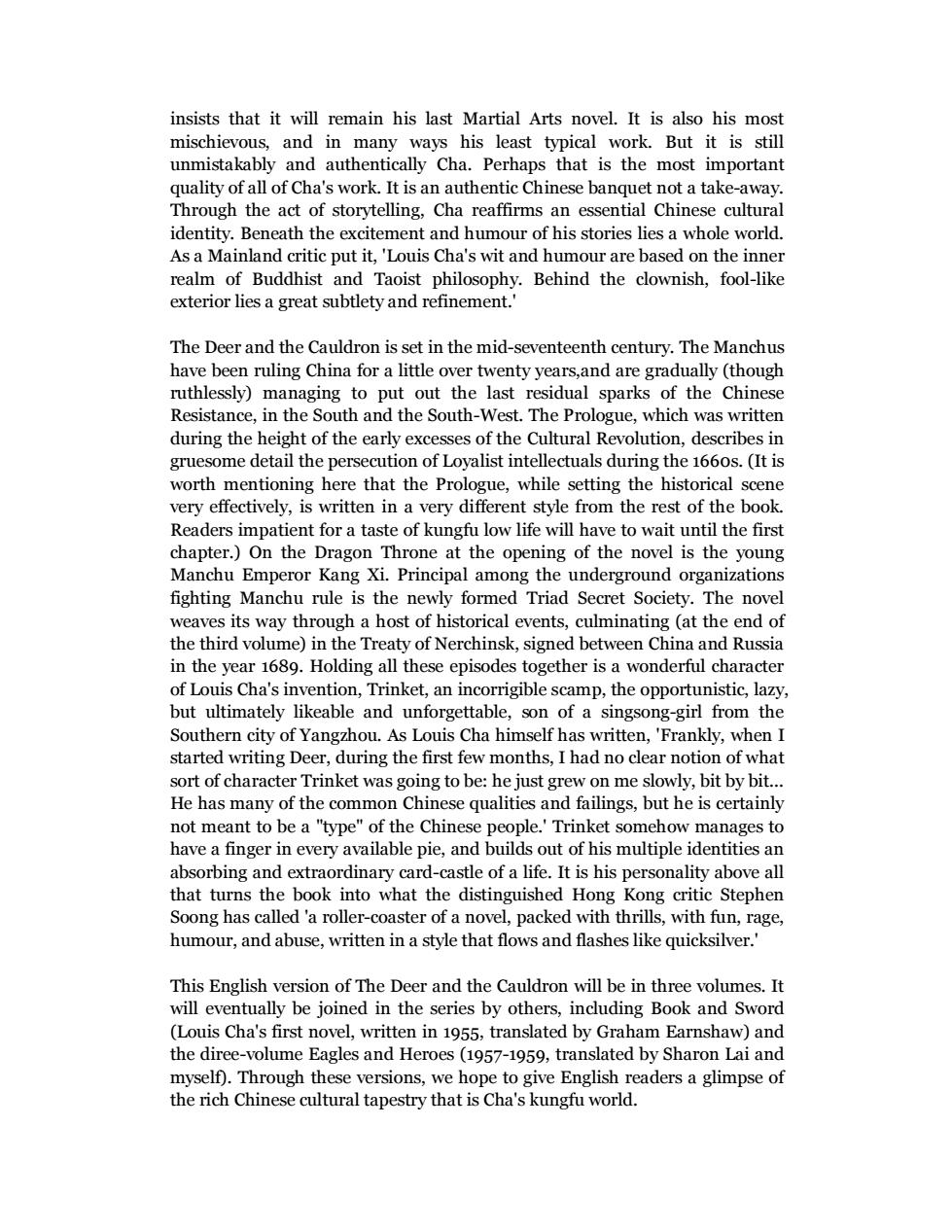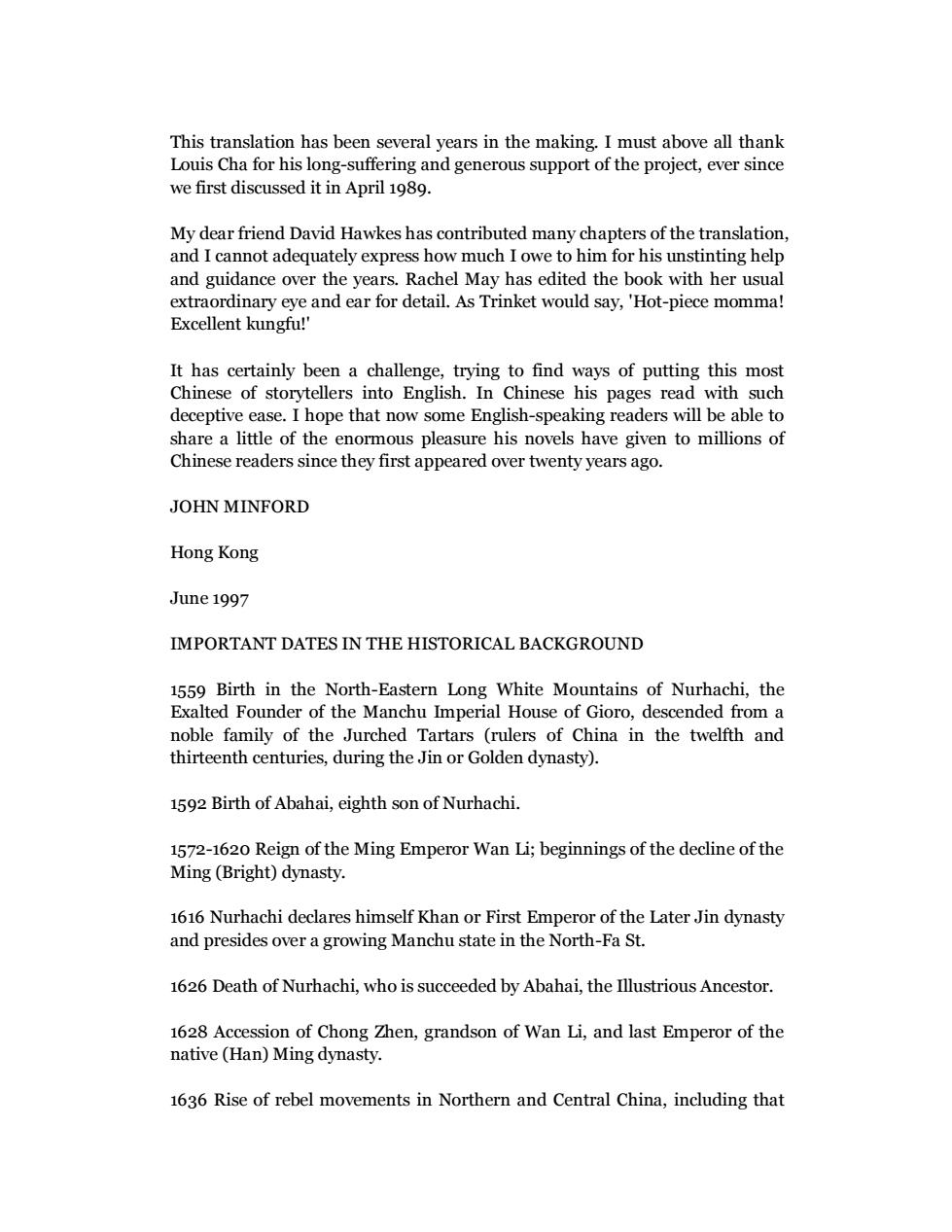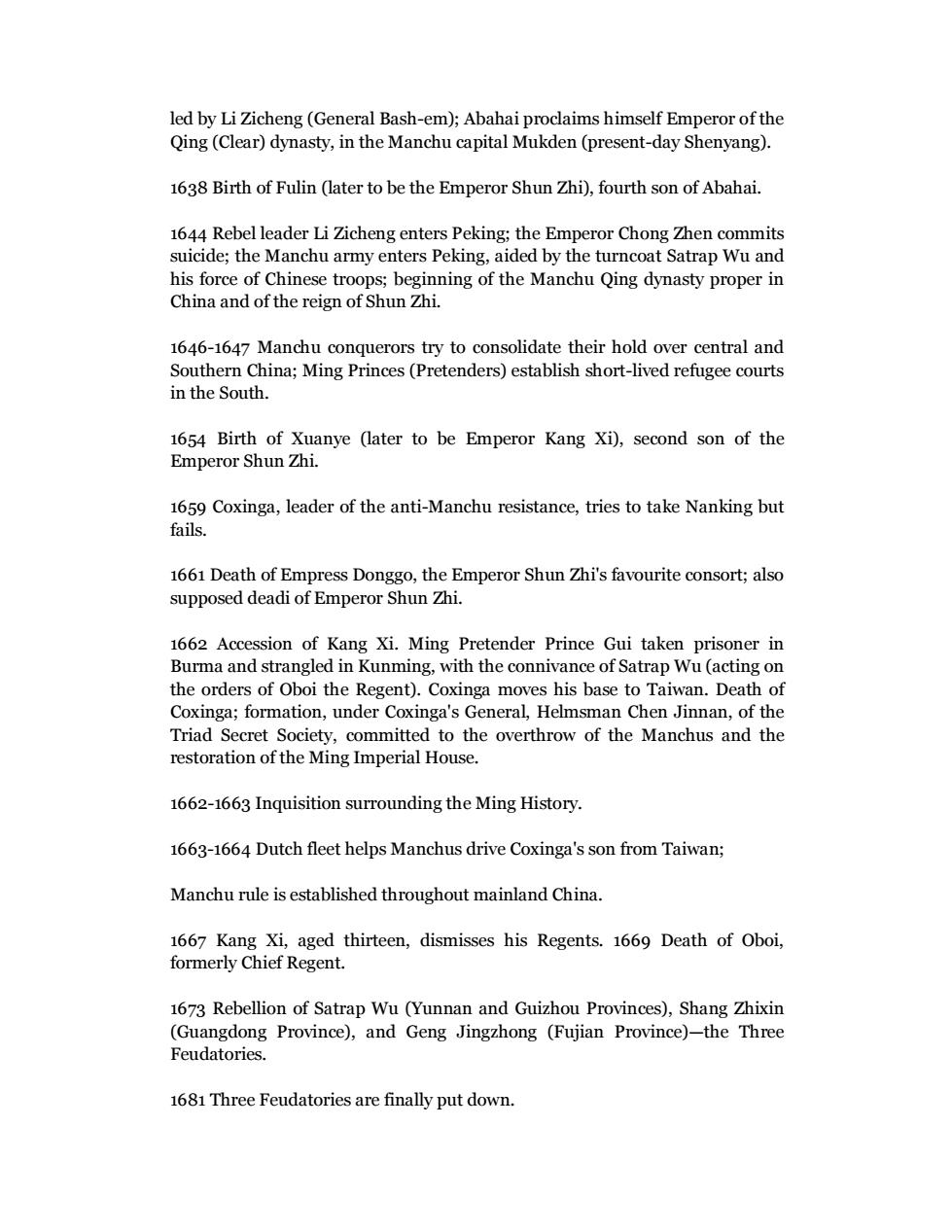
insists that it will remain his last Martial Arts novel. It is also his mostmischievous, and in many ways his least typical work. But it is stillunmistakably and authentically Cha. Perhaps that is the most importantquality of all of Cha's work. It is an authentic Chinese banquet not a take-away.Through the act of storytelling, Cha reaffirms an essential Chinese culturalidentity. Beneath the excitement and humour of his stories lies a whole world.AsaMainland criticputit,'Louis Cha'switand humourarebased ontheinnerrealm of Buddhist and Taoist philosophy. Behind the clownish, fool-likeexterior lies agreat subtletyand refinement.'The Deer and the Cauldron is set in the mid-seventeenth century.The Manchushave been ruling China for a little over twenty years,and aregradually (thoughruthlessly) managing to put out the last residual sparks of the ChineseResistance, in the South and the South-West. The Prologue, which was writtenduring the height of the early excesses of the Cultural Revolution, describes ingruesome detail the persecution of Loyalist intellectuals during the 166os. (It isworth mentioning here that the Prologue, while setting the historical scenevery effectively, is written in a very different style from the rest of the book.Readers impatient for a taste of kungfu low life will have to wait until the firstchapter.) On the Dragon Throne at the opening of the novel is the youngManchu Emperor Kang Xi. Principal among the underground organizationsfighting Manchu rule is the newly formed Triad Secret Society. The novelweaves its way through a host of historical events, culminating (at the end ofthe third volume) in the Treaty of Nerchinsk, signed between China and Russiaintheyear168g.Holdingalltheseepisodestogetherisawonderfulcharacterof Louis Cha's invention,Trinket, an incorrigible scamp,the opportunistic, lazy,but ultimately likeable and unforgettable, son of a singsong-girl from theSouthern city of Yangzhou. As Louis Cha himself has written, 'Frankly, when IstartedwritingDeer,duringthefirstfewmonths,Ihadnoclearnotionofwhatsort of character Trinket was going to be: he just grew on me slowly, bit by bit..He has many of the common Chinese qualities and failings, but he is certainlynot meant to be a "type" of the Chinese people.'Trinket somehow manages tohave a finger in every available pie, and builds out of his multiple identities anabsorbing and extraordinary card-castle of a life. It is his personality above allthat turns the book into what the distinguished Hong Kong critic StephenSoong has called 'a roller-coaster of a novel, packed with thrills, with fun, rage,humour, and abuse, written in a style that flows and flashes like quicksilver.This English version of The Deer and the Cauldron will be in three volumes. Itwill eventually be joined in the series by others, including Book and Sword(Louis Cha's first novel, written in 1955, translated by Graham Earnshaw) andthe diree-volume Eagles and Heroes (1957-1959, translated by Sharon Lai andmyself).Through these versions, we hope to give English readers a glimpse ofthe rich Chinese cultural tapestry that is Cha's kungfu world
insists that it will remain his last Martial Arts novel. It is also his most mischievous, and in many ways his least typical work. But it is still unmistakably and authentically Cha. Perhaps that is the most important quality of all of Cha's work. It is an authentic Chinese banquet not a take-away. Through the act of storytelling, Cha reaffirms an essential Chinese cultural identity. Beneath the excitement and humour of his stories lies a whole world. As a Mainland critic put it, 'Louis Cha's wit and humour are based on the inner realm of Buddhist and Taoist philosophy. Behind the clownish, fool-like exterior lies a great subtlety and refinement.' The Deer and the Cauldron is set in the mid-seventeenth century. The Manchus have been ruling China for a little over twenty years,and are gradually (though ruthlessly) managing to put out the last residual sparks of the Chinese Resistance, in the South and the South-West. The Prologue, which was written during the height of the early excesses of the Cultural Revolution, describes in gruesome detail the persecution of Loyalist intellectuals during the 1660s. (It is worth mentioning here that the Prologue, while setting the historical scene very effectively, is written in a very different style from the rest of the book. Readers impatient for a taste of kungfu low life will have to wait until the first chapter.) On the Dragon Throne at the opening of the novel is the young Manchu Emperor Kang Xi. Principal among the underground organizations fighting Manchu rule is the newly formed Triad Secret Society. The novel weaves its way through a host of historical events, culminating (at the end of the third volume) in the Treaty of Nerchinsk, signed between China and Russia in the year 1689. Holding all these episodes together is a wonderful character of Louis Cha's invention, Trinket, an incorrigible scamp, the opportunistic, lazy, but ultimately likeable and unforgettable, son of a singsong-girl from the Southern city of Yangzhou. As Louis Cha himself has written, 'Frankly, when I started writing Deer, during the first few months, I had no clear notion of what sort of character Trinket was going to be: he just grew on me slowly, bit by bit. He has many of the common Chinese qualities and failings, but he is certainly not meant to be a "type" of the Chinese people.' Trinket somehow manages to have a finger in every available pie, and builds out of his multiple identities an absorbing and extraordinary card-castle of a life. It is his personality above all that turns the book into what the distinguished Hong Kong critic Stephen Soong has called 'a roller-coaster of a novel, packed with thrills, with fun, rage, humour, and abuse, written in a style that flows and flashes like quicksilver.' This English version of The Deer and the Cauldron will be in three volumes. It will eventually be joined in the series by others, including Book and Sword (Louis Cha's first novel, written in 1955, translated by Graham Earnshaw) and the diree-volume Eagles and Heroes (1957-1959, translated by Sharon Lai and myself). Through these versions, we hope to give English readers a glimpse of the rich Chinese cultural tapestry that is Cha's kungfu world

This translation has been several years in the making. I must above all thankLouis Cha for his long-suffering and generous support of the project, ever sincewefirstdiscussed it inApril1989.MydearfriendDavid Hawkeshascontributed manychapters ofthetranslation,and I cannot adequately express how much Iowe to him for his unstinting helpand guidance over the years. Rachel May has edited the book with her usuaextraordinary eye and ear for detail. As Trinket would say,'Hot-piece momma!Excellent kungfu!'It has certainly been a challenge, trying to find ways of putting this mostChinese of storytellers into English. In Chinese his pages read with suchdeceptive ease.I hope that now some English-speaking readers will be able toshare a little of the enormous pleasure his novels have given to millions ofChinese readers since they first appeared over twenty years ago.JOHNMINFORDHong KongJune1997IMPORTANTDATESINTHEHISTORICALBACKGROUND1559Birth in the North-Eastern Long White Mountains of Nurhachi,theExalted Founder of the Manchu Imperial House of Gioro, descended from anoble family of the Jurched Tartars (rulers of China in the twelfth andthirteenth centuries, during the Jin or Golden dynasty).1592 Birth of Abahai, eighth son of Nurhachi.1572-1620 Reign of the Ming Emperor Wan Li; beginnings of the decline of theMing (Bright) dynasty.1616Nurhachi declareshimself KhanorFirst Emperorofthe Later Jin dynastyand presides overa growing Manchu state in the North-Fa St.1626 Death of Nurhachi, who is succeeded by Abahai, the Illustrious Ancestor.1628 Accession of Chong Zhen, grandson of Wan Li, and last Emperor of thenative (Han) Ming dynasty.1636 Rise of rebel movements in Northern and Central China, including that
This translation has been several years in the making. I must above all thank Louis Cha for his long-suffering and generous support of the project, ever since we first discussed it in April 1989. My dear friend David Hawkes has contributed many chapters of the translation, and I cannot adequately express how much I owe to him for his unstinting help and guidance over the years. Rachel May has edited the book with her usual extraordinary eye and ear for detail. As Trinket would say, 'Hot-piece momma! Excellent kungfu!' It has certainly been a challenge, trying to find ways of putting this most Chinese of storytellers into English. In Chinese his pages read with such deceptive ease. I hope that now some English-speaking readers will be able to share a little of the enormous pleasure his novels have given to millions of Chinese readers since they first appeared over twenty years ago. JOHN MINFORD Hong Kong June 1997 IMPORTANT DATES IN THE HISTORICAL BACKGROUND 1559 Birth in the North-Eastern Long White Mountains of Nurhachi, the Exalted Founder of the Manchu Imperial House of Gioro, descended from a noble family of the Jurched Tartars (rulers of China in the twelfth and thirteenth centuries, during the Jin or Golden dynasty). 1592 Birth of Abahai, eighth son of Nurhachi. 1572-1620 Reign of the Ming Emperor Wan Li; beginnings of the decline of the Ming (Bright) dynasty. 1616 Nurhachi declares himself Khan or First Emperor of the Later Jin dynasty and presides over a growing Manchu state in the North-Fa St. 1626 Death of Nurhachi, who is succeeded by Abahai, the Illustrious Ancestor. 1628 Accession of Chong Zhen, grandson of Wan Li, and last Emperor of the native (Han) Ming dynasty. 1636 Rise of rebel movements in Northern and Central China, including that

led by Li Zicheng (General Bash-em); Abahai proclaims himself Emperor oftheQing (Clear) dynasty, in the Manchu capital Mukden (present-day Shenyang).1638 Birth of Fulin (later to be the Emperor Shun Zhi), fourth son of Abahai.1644 Rebel leader Li Zicheng enters Peking; the Emperor Chong Zhen commitssuicide; the Manchu army enters Peking, aided by the turncoat Satrap Wu andhis force of Chinese troops; beginning of the Manchu Qing dynasty proper inChina and of the reign of Shun Zhi.1646-1647 Manchu conquerors try to consolidatetheirhold over central andSouthern China; Ming Princes (Pretenders) establish short-lived refugee courtsinthe South.1654Birth ofXuanye(later tobeEmperorKangXi),second son of theEmperor ShunZhi.1659 Coxinga, leader of the anti-Manchu resistance, tries to take Nanking butfails.1661Death of Empress Donggo, the Emperor Shun Zhi's favourite consort; alsosupposeddeadiofEmperorShunZhi.1662 Accession of Kang Xi. Ming Pretender Prince Gui taken prisoner inBurma and strangled in Kunming,with theconnivance of Satrap Wu (acting onthe orders of Oboi the Regent). Coxinga moves his base to Taiwan. Death ofCoxinga; formation, under Coxinga's General, Helmsman Chen Jinnan, of theTriad Secret Society, committed to the overthrow of the Manchus and therestoration ofthe Ming Imperial House.1662-1663 Inquisition surrounding the Ming History.1663-1664 Dutch fleet helps Manchus drive Coxinga's son from Taiwan;Manchu rule is established throughout mainland China.1667 Kang Xi, aged thirteen,dismisses his Regents.1669 Death of OboiformerlyChief Regent.1673 Rebellion of Satrap Wu (Yunnan and Guizhou Provinces), Shang Zhixin(Guangdong Province),and Geng Jingzhong (Fujian Province)-the ThreeFeudatories.1681ThreeFeudatoriesare finallyputdown
led by Li Zicheng (General Bash-em); Abahai proclaims himself Emperor of the Qing (Clear) dynasty, in the Manchu capital Mukden (present-day Shenyang). 1638 Birth of Fulin (later to be the Emperor Shun Zhi), fourth son of Abahai. 1644 Rebel leader Li Zicheng enters Peking; the Emperor Chong Zhen commits suicide; the Manchu army enters Peking, aided by the turncoat Satrap Wu and his force of Chinese troops; beginning of the Manchu Qing dynasty proper in China and of the reign of Shun Zhi. 1646-1647 Manchu conquerors try to consolidate their hold over central and Southern China; Ming Princes (Pretenders) establish short-lived refugee courts in the South. 1654 Birth of Xuanye (later to be Emperor Kang Xi), second son of the Emperor Shun Zhi. 1659 Coxinga, leader of the anti-Manchu resistance, tries to take Nanking but fails. 1661 Death of Empress Donggo, the Emperor Shun Zhi's favourite consort; also supposed deadi of Emperor Shun Zhi. 1662 Accession of Kang Xi. Ming Pretender Prince Gui taken prisoner in Burma and strangled in Kunming, with the connivance of Satrap Wu (acting on the orders of Oboi the Regent). Coxinga moves his base to Taiwan. Death of Coxinga; formation, under Coxinga's General, Helmsman Chen Jinnan, of the Triad Secret Society, committed to the overthrow of the Manchus and the restoration of the Ming Imperial House. 1662-1663 Inquisition surrounding the Ming History. 1663-1664 Dutch fleet helps Manchus drive Coxinga's son from Taiwan; Manchu rule is established throughout mainland China. 1667 Kang Xi, aged thirteen, dismisses his Regents. 1669 Death of Oboi, formerly Chief Regent. 1673 Rebellion of Satrap Wu (Yunnan and Guizhou Provinces), Shang Zhixin (Guangdong Province), and Geng Jingzhong (Fujian Province)—the Three Feudatories. 1681 Three Feudatories are finally put down

1683Manchus finally conquer Taiwan1689 Treaty of Nerchinsk, signed by China and Russia.For an excellent, readable account of the historical background to The Deerand the Cauldron, see the first three chapters of Jonathan Spence's book, TheSearch for Modem China (New York: Norton,1990).QLOSSARYOFPEOPLEANDPLACESABAHAI (1592-1643) Eighth son of Nurhachi, father of the Emperor Shun Zhi.BASALAWARMI (died 1382) Mongol Prince of LiangBIG BEAVER Guan Anji, bearded Triad.BLACKDRAGONseeShiSongBLOSSOMOneoftheEmpressDowager'smaids-in-waitingBOFAMILYTREESMapleandPine,twoBobrothersBO HANFENG, Maple Mu retainer, descended from one of the originalPaladins.BO HANSONG, Pine Elder brother of the above, skilled at flicking chopsticks,killed by Xu the Eight-Armed Ape.BRIDGE OF HEAVEN District of Peking famous for its storytellers,acrobats,and other street-performers.CAI DEZHONG Elderly Triad, formerly an officer in Coxinga's army, Master ofthe Lotus Flower Lodge.CHENGWEIFAN ChineseSecretary toSongkui, Manchu Military Governor ofHangzhou.CHONG ZHEN (1611-1644)ZhuYoujian, last Emperor of the Ming dynasty,whohanged himself when the rebel leader Li Zicheng entered Peking.COXINGA(1624-1662)This wasthe Western name (pronounced with a hard'cand sometimes written'Koxinga', based on the title Guo-xing-ye given him bythe Ming Court) for the naval warrior Zheng Chenggong, Marshal Zheng
1683 Manchus finally conquer Taiwan. 1689 Treaty of Nerchinsk, signed by China and Russia. For an excellent, readable account of the historical background to The Deer and the Cauldron, see the first three chapters of Jonathan Spence's book, The Search for Modem China (New York: Norton, 1990). QLOSSARY OF PEOPLE AND PLACES ABAHAI (1592-1643) Eighth son of Nurhachi, father of the Emperor Shun Zhi. BASALAWARMI (died 1382) Mongol Prince of Liang. BIG BEAVER Guan Anji, bearded Triad. BLACK DRAGON see Shi Song BLOSSOM One of the Empress Dowager's maids-in-waiting. BO FAMILY TREES Maple and Pine, two Bo brothers. BO HANFENG, Maple Mu retainer, descended from one of the original Paladins. BO HANSONG, Pine Elder brother of the above, skilled at flicking chopsticks, killed by Xu the Eight-Armed Ape. BRIDGE OF HEAVEN District of Peking famous for its storytellers, acrobats, and other street-performers. CAI DEZHONG Elderly Triad, formerly an officer in Coxinga's army, Master of the Lotus Flower Lodge. CHENG WEIFAN Chinese Secretary to Songkui, Manchu Military Governor of Hangzhou. CHONG ZHEN (1611-1644) Zhu Youjian, last Emperor of the Ming dynasty, who hanged himself when the rebel leader Li Zicheng entered Peking. COXINGA (1624-1662) This was the Western name (pronounced with a hard 'c' and sometimes written 'Koxinga', based on the title Guo-xing-ye given him by the Ming Court) for the naval warrior Zheng Chenggong, Marshal Zheng

Prince of Yanpmg, leader until his death of the anti-Manchu resistance,cryptically referred to as 'Dragon Brother' by the Triads. His father was aFujianese pirate and adventurer, his mother Japanese; the remnants of hisarmy are supposed to have formed the first Triad Lodges.CRANE, Father Taoist priest at Wudang Temple.DELMEKMongolGeneraldefendingthe last Mongol stronghold inYunnan against old Duke Mu's Ming troops.DOLONGNewly appointedColonel inthe Palace GuardsDONGGO,Empress (1639-1661) The'fox-woman', favourite consort of theEmperor Shun Zhi, and motherof Prince Rong.DORGON (1612-165o) Fourteenth son of Nurhachi, regent during the earlyyears of Shun Zhi's reign.DRAGONBROTHER seeCoxingaEBILUN(died1674)SupporterofOboi.EMEI, Mount Buddhist sacred mountain in Sichuan Province, Western China,home ofone school of kungfu.EMPRESS DOWAGER Wife of Shun Zhi, daughter of the Mongol PrinceKorcin, of the Borjigit clan; referred to by Trinket as the'old Whore'.FAN, Brother Fan Gang, Triad with bass voice.FENG, Brother Feng Jizhong, Triad with superb kungfu skills.FU, Prince (died 1646)First Ming Pretender, cousin of the last Ming EmperorChong Zhen; briefly made Emperor in the Southern city of Nanking, he wascaptured by me Manchus and died in Peking.GAOYANCHAO Young Triad, member of the Green Wood LodgeGOLDEN GATE, Master of Martial Arts instructor of Satrap Wu's guards.GOONG-GOONGTerm of address for a Palace Eunuch.GREEN GANGSmugglers'gang from Yangzhou.GUYANwU (1613-1682)Renowned Loyalist scholar and philosopher
Prince of Yanpmg, leader until his death of the anti-Manchu resistance, cryptically referred to as 'Dragon Brother' by the Triads. His father was a Fujianese pirate and adventurer, his mother Japanese; the remnants of his army are supposed to have formed the first Triad Lodges. CRANE, Father Taoist priest at Wudang Temple. DELMEK Mongol General defending the last Mongol stronghold in Yunnan against Old Duke Mu's Ming troops. DOLONG Newly appointed Colonel in the Palace Guards. DONGGO, Empress (1639-1661) The 'fox-woman', favourite consort of the Emperor Shun Zhi, and mother of Prince Rong. DORGON (1612-1650) Fourteenth son of Nurhachi, regent during the early years of Shun Zhi's reign. DRAGON BROTHER see Coxinga EBILUN (died 1674) Supporter of Oboi. EMEI, Mount Buddhist sacred mountain in Sichuan Province, Western China, home of one school of kungfu. EMPRESS DOWAGER Wife of Shun Zhi, daughter of the Mongol Prince Korcin, of the Borjigit clan; referred to by Trinket as the 'Old Whore'. FAN, Brother Fan Gang, Triad with bass voice. FENG, Brother Feng Jizhong, Triad with superb kungfu skills. FU, Prince (died 1646) First Ming Pretender, cousin of the last Ming Emperor Chong Zhen; briefly made Emperor in the Southern city of Nanking, he was captured by me Manchus and died in Peking. GAO YANCHAO Young Triad, member of the Green Wood Lodge. GOLDEN GATE, Master of Martial Arts instructor of Satrap Wu's guards. GOONG-GOONG Term of address for a Palace Eunuch. GREEN GANG Smugglers' gang from Yangzhou. GU YANWU (1613-1682) Renowned Loyalist scholar and philosopher